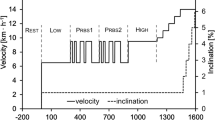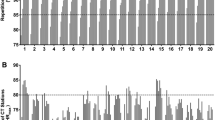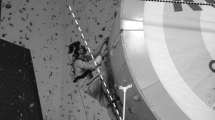Summary
The tolerable work duration (t) for high-intensity cycling is well described as a hyperbolic function of power (W):W=(W'·t −1)+W a , whereW a is the upper limit for sustainable power (lying between maximumW and the threshold for sustained blood [lactate] increase,Θ lac), andW' is a constant which defines the amount of work which can be performed >W a . As training increases the tolerable duration of high-intensity cycling, we explored whether this reflected an alteration ofW a ,W' or both. Before and after a 7-week regimen of intense interval cycle-training by healthy males, we estimated (^)Θ lac and determined maximum O2 uptake\((\mu \dot V_{O_2 } )\);W a ;W'; and the temporal profiles of pulmonary gas exchange, blood gas, acid-base and metabolic response to constant-load cycling at and aboveW a . Although training increased\(\hat \Theta _{lac} \) (24%),\(\mu \dot V_{O_2 } \) (15%) andW a (15%),W' was unaffected. For exercise atW a , a steady state was attained for\(\dot V_{O_2 } \), [lactate] and pH both pre- and post-training, despite blood [norepinephrine] and [epinephrine] ([NE], [E]) and rectal temperature continuing to rise. For exercise >W a , there was a progressive increase in\(\dot V_{O_2 } \) (resulting in\(\mu \dot V_{O_2 } \) at fatigue), [lactate], [NE], [E] and rectal temperature, and a progressive decrease for pH. We conclude that the increased endurance capacity for high-intensity exercise following training reflects an increasedW asymptote of theW−t relationship with no effect on its curvature; consequently, there is no appreciable change in the amount of work which can be performed aboveW a . Furthermore, regardless of training status,W a represents the upper power limit at which\(\dot V_{O_2 } \), blood [lactate] and blood pH can eventually be stabilized. Exercise >W a , in contrast, is characterized by a steadily increasing\(\dot V_{O_2 } \) and blood [lactate], a falling blood pH and consequently, imminent fatigue.
Similar content being viewed by others
References
Boobis LH, Brooks S, Cheetham ME, Williams C (1987) Effect of sprint training on muscle metabolism during treadmill sprinting in man. J Physiol 384:31P
Casaburi R, Storer TW, Ben-Dov I, Wasserman K (1987) Effect of endurance training on possible determinants of\(\dot V_{O_2 } \)during heavy exercise. J Appl Physiol 62:199–207
diPrampero PE (1981) Energetics of muscular exercise. Rev Physiol Biochem Pharmacol 89:143–222
Forster HV, Dempsey JA, Thompson J, Vidruk E, DoPico GA (1972) Estimation of arterial PO2, PCO2, pH and lactate from arterialized venous blood. J Appl Physiol 32:134–137
Gollnick PD, Armstrong RB, Saltin B, Saubert CW, Sembrowich WL, Shepherd RW (1973) Effect of training on enzyme activity and fiber composition of human skeletal muscle. J Appl Physiol 34:107–111
Gollnick PD, Hermansen L (1973) Biochemical adaptations to exercise: anaerobic metabolism. Exerc Sport Sci Rev 1:1–43
Hill AV (1927) Muscular movement in man. McGraw-Hill, New York
Hohorst HL (1963) −(+)-lactate: determination with lactic dehydrogenase DPN. In: Bergmeyer HU (ed) Methods of enzymatic analysis. Academic Press, New York, pp 266–270
Holloszy JO, Coyle EF (1984) Adaptations of skeletal muscle to endurance exercise and their metabolic consequences. J Appl Physiol 56:831–838
Hoppeler H, Howald H, Conley K, Lindstedt SL, Claassen H, Vock P, Weibel ER (1985) Endurance training in humans: aerobic capacity and structure of skeletal muscle. J Appl Physiol 59:320–327
Kelman GR, Nunn JF (1966) Nomograms for correction of blood PO2, PCO2, pH, and base excess for time and temperature. J Appl Physiol 21:1484–1490
Linnarsson D (1974) Dynamics of pulmonary gas exchange and heart rate changes at start and end of exercise. Acta Physiol Scand [Suppl] 415:1–68
Monod H, Scherrer J (1965) The work capacity of a synergic muscular group. Ergonomics 8:329–338
Moritani T, Nagata A, de Vries HA, Muro M (1981) Critical power as a measure of physical work capacity and anaerobic threshold. Ergonomics 24:339–350
Morrison DF (1976) Multivariate statistical methods. McGraw-Hill, New York, pp 33–34
Poole DC, Gaesser GA (1985) Response of ventilatory and lactate thresholds to continuous and interval training. J Appl Physiol 58:1115–1121
Poole DC, Ward SA, Gardner G, Whipp BJ (1988) A metabolic and respiratory profile of the upper limit for prolonged exercise in man. Ergonomics 31:1265–1279
Porter R, Whelan J (1981) Human muscle fatigue: physiological mechanisms. Pitman, Bath
Wasserman K, Van Kessel AL, Burton GG (1967) Interaction of physiological mechanisms during exercise. J Appl Physiol 22:71–85
Watson E (1981) Liquid Chromatography with electrochemical detection for plasma norepinephrine and epinephrine. Life Sci 28:493–497
Wells JG, Balke B, Van Fosson BD (1957) Lactic acid accumulation during work. A suggested standardization of work classification. J Appl Physiol 10:51–55
Whipp BJ, Mahler M (1980) Dynamics of pulmonary gas exchange during exercise. In: West JB (ed) Pulmonary gas exchange, vol II. New York, Academic Press, pp 33–96
Whipp BJ, Davis JA, Torres F, Wasserman K (1981) A test to determine parameters of aerobic function during exercise. J Appl Physiol 50:217–221
Whipp BJ, Huntsman DJ, Storer T, Lamarra N, Wasserman K (1982) A constant which determines the duration of tolerance to high-intensity work. Fed Proc 41:1591
Wilkie DR (1981) Shortage of chemical fuel as a cause of fatigue: studies by nuclear magnetic resonance and bicycle ergometry. In: Porter R, Whelan J (eds) Human muscle fatigue: physiological mechanisms. Pitman, Bath, pp 102–114
Author information
Authors and Affiliations
Additional information
Supported in part by a UCLA Graduate Division Doctoral Research Award
Rights and permissions
About this article
Cite this article
Poole, D.C., Ward, S.A. & Whipp, B.J. The effects of training on the metabolic and respiratory profile of high-intensity cycle ergometer exercise. Europ. J. Appl. Physiol. 59, 421–429 (1990). https://doi.org/10.1007/BF02388623
Accepted:
Issue Date:
DOI: https://doi.org/10.1007/BF02388623




